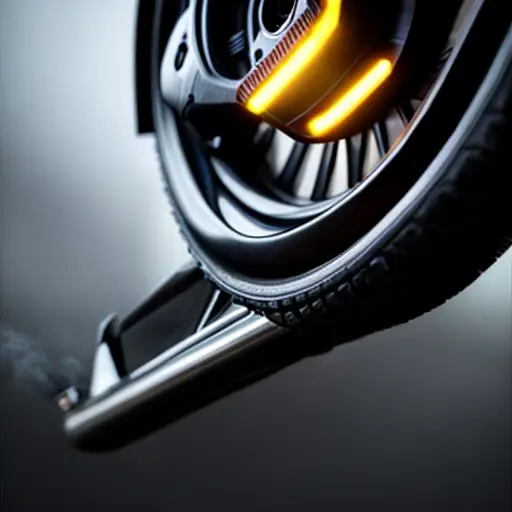Understanding Brake Shoes: An Introduction to their Function and Importance
Brake shoes, my friends, are the unsung heroes of the automotive world. Picture this: you're cruising down the road, wind in your hair, feeling like a true road warrior. But wait, what's that? A squirrel darts across the street, and you need to stop faster than a cheetah chasing its lunch. Enter the brake shoes, those trusty little devils that press against the brake drum, creating the friction needed to slow down your mighty chariot. Without these humble yet mighty components, we'd all be careening into each other like bumper cars on a caffeine high. So, next time you hit the brakes and come to a smooth stop, take a moment to appreciate the unsung heroes that are brake shoes. They may not be glamorous, but boy, are they important!
The Anatomy of Brake Shoes: Exploring the Components and Design
Brake shoes are an essential component of drum brake systems, which were widely used in automobiles until the late 20th century. Unlike modern disc brakes, drum brakes utilize brake shoes that press against the inner surface of a rotating drum to slow down or stop the vehicle. Interestingly, brake shoes are typically made from a heat-resistant material called friction material, which is composed of various substances such as asbestos, carbon, and metal fibers. This unique combination allows the brake shoes to withstand the intense heat generated during braking, ensuring efficient and reliable performance.
Let's dive into the fascinating world of brake shoes, shall we? These seemingly simple contraptions are actually quite intricate in their design. Picture this: you've got the brake lining, that tough-as-nails material that grips the drum like a determined octopus. Then there's the brake shoe itself, a sturdy metal frame that holds everything together like a superhero's cape. And let's not forget about the return springs, those little guys that ensure the brake shoes retreat gracefully after doing their job. It's like a well-choreographed dance, with each component playing its part to ensure your vehicle stops on a dime. So, the next time you hit the brakes and feel that satisfying jolt of deceleration, take a moment to appreciate the intricate anatomy of those unsung heroes called brake shoes. They may not be the flashiest part of your ride, but boy, do they know how to stop the show!
How Brake Shoes Work: Unraveling the Mechanism Behind Stopping Power

Let's take a deep dive into the inner workings of brake shoes and unravel the mystery behind their stopping power. When you press down on the brake pedal, a series of events is set into motion. Hydraulic fluid is sent through the brake lines, exerting pressure on the wheel cylinder. This pressure then pushes the brake shoes outwards, making them come into contact with the brake drum. It's like a perfectly choreographed ballet, with the brake shoes and drum working together to slow down your vehicle.
But how do brake shoes actually stop your car? Well, it all comes down to friction. The brake shoes are lined with a special material, usually made of heat-resistant compounds like asbestos or organic fibers. When the brake shoes press against the drum, this lining creates friction, converting the kinetic energy of your moving vehicle into heat energy. It's like rubbing your hands together vigorously on a cold winter day to warm them up - except on a much larger scale.
The heat generated by this friction is then dissipated into the surrounding air, allowing your vehicle to come to a safe and controlled stop. It's a delicate balance, as too much heat can cause the brake shoes to overheat and lose their effectiveness. That's why brake shoes are designed with cooling fins or vents, allowing air to circulate and prevent excessive heat buildup.
So, the next time you hit the brakes and feel that reassuring jolt of deceleration, remember the intricate mechanism at play. Brake shoes, with their friction-inducing lining and precise design, are the unsung heroes that bring your vehicle to a halt. They may not be the flashiest part of your ride, but their function and importance cannot be overstated. So, let's give a round of applause to the humble brake shoes for keeping us safe on the roads!
Brake Shoe Maintenance and Replacement: Tips for Ensuring Optimal Performance and Safety
Fun fact: Brake shoes are not actually shoes that you wear on your feet, but rather an essential component of a vehicle's braking system. They are curved metal plates lined with friction material, designed to press against the brake drum or rotor when the brakes are applied. So, while they may not be fashionable footwear, brake shoes play a crucial role in keeping us safe on the roads!
Maintaining and replacing brake shoes is crucial for optimal performance and safety on the road. Over time, the brake lining can wear down, reducing its ability to create friction and effectively stop your vehicle. Regular inspections are key to catching any signs of wear or damage early on. If you notice squeaking or grinding noises when applying the brakes, it's a clear indication that your brake shoes may need replacing. Additionally, keeping an eye on the thickness of the lining and checking for any cracks or uneven wear is essential. Remember, neglecting brake shoe maintenance can compromise your stopping power, so don't wait until it's too late. Stay proactive and ensure your brake shoes are in top-notch condition for a smooth and safe ride.


